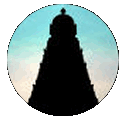 |
 |
 |
http://www.varalaaru.com A Monthly Web Magazine for South Asian History [187 Issues] [1839 Articles] |
 |
 |
 |
http://www.varalaaru.com A Monthly Web Magazine for South Asian History [187 Issues] [1839 Articles] |
|
Issue No. 115
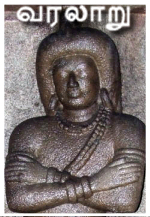
இதழ் 115 [ ஜனவரி 2015 ] 
இந்த இதழில்.. In this Issue.. 
|
Series:
Pudukkottai Cave Temples
The Central Rock Cut Cave
The inner prakara leads to the closed pillared mandapa with a doorway in the east and flanked by dvarapalas. The mandapa adjoins the rock cut cave in all its sides. The wall enclosures of the mandapa possess the usual segmentations of adhishthana, bhitti and prastara. Inside in the middle of the pillared hall is the balitala, Nandi are placed facing the sanctum and on the northern side the bronze sculptures are kept inside in a closed provision. The rock cut cave consists of a facade, a rectangular mukhamandapa and a cubical sanctum all facing east. The Facade The facade is 5.46mts in north-south and 0.59mts in the east-west directions and to a height of 0.07mts. It consists of two pillars in the middle and two pilasters each one at the corners. The pillars and the pilasters are formed 0.05mts inside the raised floor of the facade. In front of the facade on both the sides the mother rock extends 1.63mts in the south and 1.55mts in the north. The rough rock brow that extends to a length of 0.96mts forms the kapota of the rock cut cave. The canopy of the kapota is flat and well finished. The vajana is running in the roof and its extension on the sides along the pillars and kapota is absent. Above the kapota on the faces of the mother rock an unfinished attempt is seen. The rock cut floor extension in the front of the facade is not seen instead paved with stone slabs. The pillars and pilasters are massive with squares on the edges and kattu in the middle. Comparing the upper square the lower square and the kattu are long. The potikas are angular and taranga with median patta. The angular is not absolute instead it is slender formation with three tarangas in the base and five for the angular portion and a big taranga is shown for the intersecting region. On the faces of the potikas, contour is formed along the taranga in which the central one is given a scroll finish. The heavy corbels bear the uttira and above it a thin vajana buffers the roof and the uttira. The Mukhamandapa The facade leads to the rectangular mukha mandapa which is 6.55mts in the north-south and 3.23mts in east-west directions.6 The floor and the roof of the mandapa are well finished. The sanctum is formed on the back wall of the mandapa and the lateral walls are adorned with huge bas-relief sculptures. Brahmakanta pilasters are shown at all the corners of the mandapa wall. The potikas above the pillars are taranga and they bear the uttira of the mandapa. On the lateral walls niches are formed to house the deities viz., a huge Ganesa on the south and Uma-sahita on the north. Vajana is running throughout the mandapa. In the centre of the back wall the sanctum is formed projecting 0.28mts inside the mandapa. The sanctum is segmented as adhishthana, bhitti, prastara and also adorned with the personified weapons of Lord Siva flanking the entrance. On the back wall of the mandapa, to the north of the sanctum, that is, in between the sanctum northern wall and the mandapa northern wall, nearly to a length of 1.09mts scooping is seen, which might be an attempt of perambulation to the sanctum. The maximum depth reached is 2.07mts.[7] In the middle of the southern wall a niche is formed to a height of 1.96mts, to a width of 1.41mts and to a depth of 0.42mts. The niche is flanked by brahmakanta pilasters and the potikas above the pilasters are angular and taranga. The niche houses a huge seated bas-relief Ganesa. A lengthy stone slab is laid in front of the niche as balitala. As like on the northern wall of the mandapa, in the centre, a niche is formed to a height of 1.92mts, to a width of 1.35mts and to a depth of 0.14mts. The niche is flanked by brahmakanta pilasters and the potikas above the pilasters are angular and taranga. One of the interesting aspect of the niche is it is highlighted as a shrine by the addition of adhishthana and the prastara. The adhishthana consists of jagati, rudra kumuda, kantha with pada flanked by kampa and the pattika. The prastara components consist of uttira, vajana, kapota and the tala ends with the bhumidesa. The kapota is flexed and overhanging with ridge formation in the edges and the corners are pointed up. Alinga and anthari shown above the kapota forms the bhumidesa. It is the only rock cut cave in the district with the feature of well formed kapota as it is absent through out the district even for the sanctum. The shrine houses Uma-sahita in seated posture and to the left of the goddess is seen a maid in standing posture. The pattika forms the floor of the niche in which Siva is seated in lalitasana and to his left is the goddess seated in same posture. As like the southern niche, in front of the northern niche also a lengthy stone slab is placed as balitala. 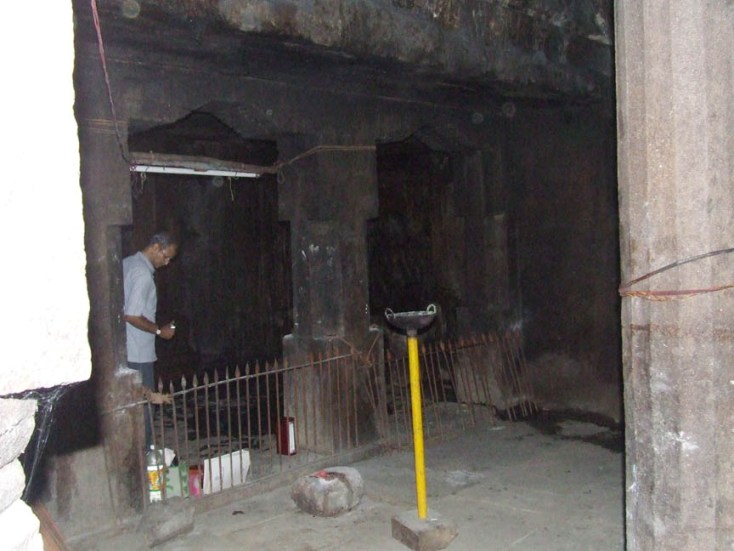 The Anterior Wall of the Sanctum The anterior wall of the sanctum is segmented as adhishthana, bhitti, prastara and in the centre of the wall an aperture is formed to a width of 0.95mts and to a height of 2.02mts. The adhishthana is padabandha type with the components of upana, jagati, rudra kumuda, kantha with pada flanked by kampa, pattika and upari kampa. Above the adhishthana raises the wall sectioned by four brahmakanta pilasters. The pilasters in the middle flank the entrance to the sanctum and in between the pilasters on both the sides niches are formed to house personified weapons of the Siva viz., Mazhuvadiyar and the Suladeva. The niche on the south is 1.68 mts height, 1.12 mts width and 0.18 mts depth. The niche on the north is 1.70mts height, 1.11mts width and 0.20mts depth. The southern niche is adorned by Mazhuvadiyar and the northern niche by Suladeva. The potikas above the pilasters are single limbed, angular-taranga with four tarangas shown in the horizontal section and six in the vertical section. A contour scroll is shown on the face of the potikas extending from the intersecting taranga. The single hand of the potikas that extend towards the niche bears the uttira above. A thin vajana buffers the roof and the uttira. Sanctum The entrance to the sanctum is cut in the middle of the anterior wall flanked by the inner two pilasters and a flight of two rock cut steps leads to the sanctum. Door frames are arranged inside the rock cut entrance which forms the jambs, sill and lintel. The lintel and sill are decorated as kantha pada feature. The width between the jambs is 0.71mts and the height is 1.67mts. The sanctum is little lower in level to the sill. The cubical cell is 2.96mts in east-west and 3.20mts in north-south directions and the height of the sanctum is 2.34mts. Sanctum houses the deity Lord Siva in the form of Linga, both the avudaiyar and the bana formed out of the mother rock. The octagonal Avudaiyar shown as padabandha adhishthana with the components like jagati, rudra kumuda, kantha with pada flanked by kampa on both sides, urthuva padma, pattika and uparikampa. The height of the avudaiyar is 0.57mts and the rudra bana is 0.61mts.8,9 A small gomukha is shown on the north. The pit that shown below the gomukha is at present closed. An outlet for the sanctum water is seen on the northern side of the sanctum wall and for the proper flow of the water, a chute is formed on the mandapa floor along the northern lateral wall and pass out along the northern pilaster. Both the uttira and vajana are absent in the sanctum. 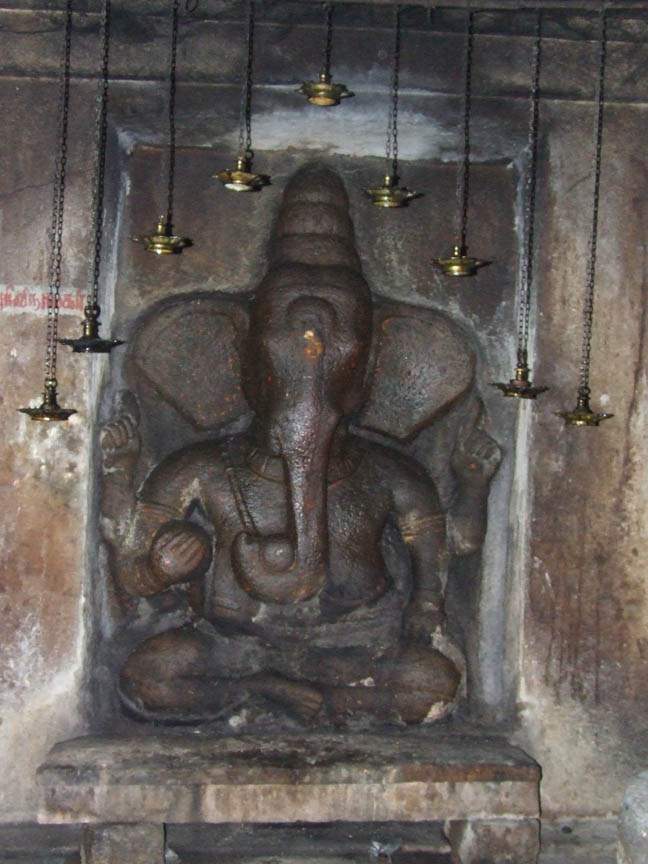 Ganesa Ganesa is seated in cross legs. His back hands carrying tusk in the left and a bud in the right whereas his front right hand is carrying a big motaka and the front left hand is rested on the thigh by holding the udarabandha worn around the abdomen. Karandamakuta adorns his head besides each layer is decked with flower petals. He is wearing a short attire and beaded yajnopavita is worn in upavita fashion from right to left. Charapali, armlets, bangles, udarabandha are the ornaments adorn him. His proboscis is right turned and holding a motaka. The motaka carried by the deity on the right front hand is huge. 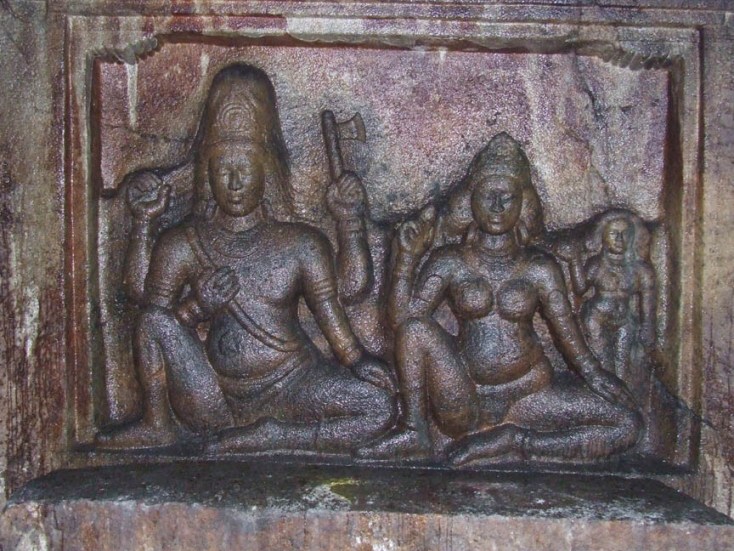 Uma-Sahita A rare depiction of Siva-Parvati duo10 adorns the northern wall of the mandapa. The shrine houses the god and the goddess in seated posture and to the left of the goddess is seen a maid in standing posture. The surface of the pattika forms the floor of the niche in which Siva is seated in lalitasana and to his left is the goddess in same posture. Both are with their left leg folded flat on the niche floor, their right leg folded and placed upright. The locks of the god is arranged as jatamakuta and decked with head ornament, crescent moon on the left and skull on the right side, besides few of the locks left untied. His back hands carry axe in the left and one of the untied lock in his right hand whereas the front right hand is placed in his right chest above the yajnopavita and his front left hand is placed on his left thigh. The goddess seated in same posture with locks arranged as jatabhara and decked with head gear. Her left hand is on the left thigh and the right hand is carrying a bud. Both the deities are adorned with ornaments like charapali, patrakundalas, armlets, bangles and their lower garment drape upto their calf leg. Bangles and charapali are stone studded for both, while the God is wearing coiled armlet the Goddess is wearing keyura. Besides the god is adorned with hip ornament and the goddess is adorned with anklet. The maid standing to the left of the goddess is draped in a short attire extending upto her knee and her locks arranged as jatabhara. Patrakundalas, charapali, bangles and armlets are the ornaments worn by her. The maid is carrying a basket on her right hand lifted upto the shoulders, which might be offering to the deities and her left hand is stretched to her left. It is the only rock cut cave in the district with Uma-sahita depiction. Both the god and the goddess are simple to the core lack the usual sophisticated appearance and the depiction carries more a folk tone. Besides, to make it a significant feature of the cave the niche in which the panel is present is highlighted as a shrine. Both the panel and the shrine forms a unique features of the district. Usually yajnopavita is worn from left to right but it is interesting to note both Ganesa and Siva in the Uma-sahita panel wore yajnopavita in a peculiar way from right to left. Ayudha-Purushas Mazhuvadiyar The Mazhuvadiyar is standing in sama on the floor of the southern niche facing straight, head slightly tilted towards sanctum and hands folded submissively. His locks are arranged as jatabhara, formed as a thick pad and the machete is shown in the centre. The lower garment is draping upto the ankle in which the centre is gathered and fastened under the hip belt. The hip belt with a square clasp at the centre fastens the lower garment around the waist and the excess girdle is formed as a single bow knot in the centre. Over the lower garment the idaikattu is slackly worn and heavily knotted at the left which dangles upto his ankle. Patrakundalas, heavy bangles, chavadi are the ornaments adorn by him. A double stringed beaded yajnopavita is worn in upavita fashion from left to right. Chavadi is also beaded. The small fingers of both the hands are adorned with ring. Such icon is also seen at Sathyagiriswara and scholars opine that it might be the beatification of a local personality. 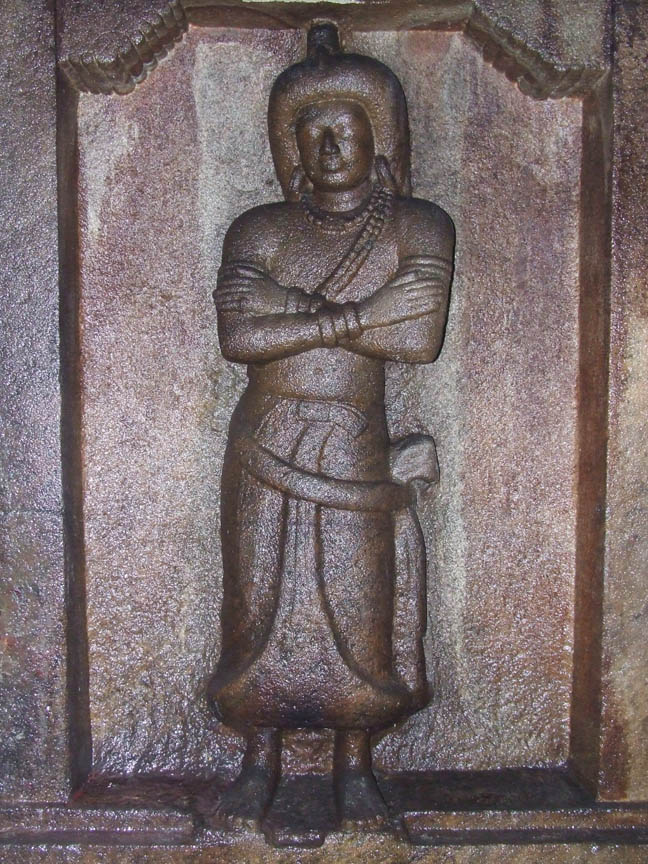 Suladeva Suladeva in the northern niche is standing with his right leg in sama and the left leg form a swastika behind the right leg and the foot placed in agratalacancara. His lower garment is a short attire extending upto his knee and the idaikattu is slackly worn above it. The attire is fastened by a hip belt and the excess girdle is knotted at the centre. The heavy knots of the idaikkattu are suspended on both the sides. His locks are arranged as karandamakuta with some untied locks spreading behind his shoulders and adorned with head ornament. Patrakundalas, charapali, coiled armlets, heavy bangles and a hip ornament are adorned by him. The trident is shown behind his head in which only the outer forks are visible. A garland is worn on the head over the makuta. He is holding a mace on his right hand which is placed to his left and stretching his left hand over it. The mace is lengthy, extending upto his chest which has a thinned handle ended with rounded tip and a blunt bottom. A snake is seen entwining the mace. He is standing in a very casual way which poses a stylish look. 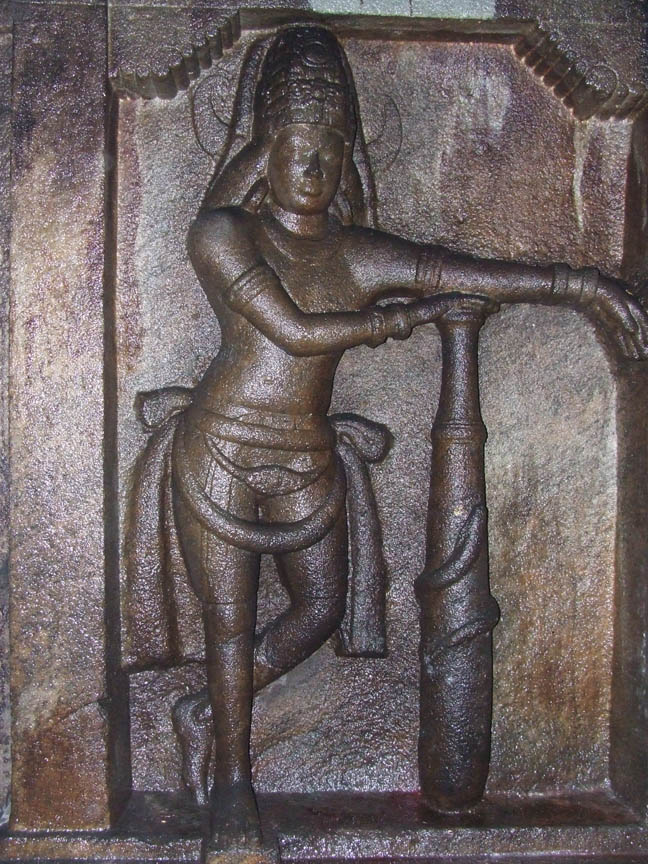 Chandeswara Chandeswara is seated in suhasana with his left leg folded flat on the floor of the platform and right leg dangling down. The left hand is resting on the thigh and right hand is holding the axe which is rested on his right shoulder. His locks are arranged as jatabhara, his attire draping upto his thigh which is secured by the hip belt and yajnopavita is worn in upavita fashion. Bangles, armlets, charapali, udarabandha, patrakundalas are the ornaments worn by him. Inscriptions Nearly sixty five inscriptions11 are copied from the rock cut cave. Among this four[12] belong to the central rock cut cave, five13 to the northern rock cut cave and the rest are from the other places in the temple complex. The southern rock cut cave lack inscriptions. The inscriptions in the central rock cut cave belong to the Pallava period. An inscription[14] on a pillar in the central rock cut shrine speaks about the gift of 220 naligai of rice to be cooked and distributed to 110 Brahmins on the day of Thiruvadirai in honour of the God of Thirukunrakkudi by one Kodai Mayindan on behalf of Mayindan Virakadaiyan. Another inscription[15] on the southern end of the rock cut shrine of the central cave belong to the 3rd regnal year of the Pallava king Nandivarma who can be either Nandivarma II (C.E.723-788) or Nandivarma III (C.E. 839-862). The inscription details the gift of 200 nalis of rice for cooking and distribution on the Thiruvadirai day by Ganavati Mallu also called Pakaichandira Visai-araiyan of Vaduvur in Mipulai nadu. These two hundred nazhis are for hundred persons. Another inscription16 on the northern end of the central cave belong to the 5th regnal year of Pallava Dantivarma (C.E.788-839). The inscriptions details about the excavation of a tank called Vali Eri by one Vali Vadukan otherwise called Kalimurdha Ilavaraiyan a subordinate of Marappiduvinar Peradi-araiyar. The inscriptions that are found in the northern rock cut cave belong to the Chola period and are much damaged. A 27th regnal year inscription17 of Rajathiraja mentions the endowment of a lamp for the God by one Thuditharaiyan Kalla Kannan. The 40th regnal year inscription18 of Kulothunga III is much damaged. The 2rd regnal year inscription19 of Thiribhuvana chakravarthin Sri Rajathirajadeva (unidentified) speaks about register of sale deed of 5 ma and 3 kani of temple land for 200 kasu. A much damaged inscription20 mentions 3rd regnal year of Thiribhuvana chakravarthin Sri Rajathirajadeva. A partially built in inscription21 speaks about record of a gift of land to the temple by a native of Sirrambur in Tiruvelundur-nadu, a sub-division of Jayankondasola-valanadu. Period of the Cave Foundation inscription is absent in this rock cut cave hence a relative dating is possible with the help of earliest available inscriptions and architecture. Inscriptions of Pallavas Nandivarma and Dantivarma are found in the rock cut cave. For the 3rd regnal year inscription of Nandivarama, there is possibility of him being either Nandivarma II (C.E. 723-788)22 or Nandivarma III (C.E. 839-862).23 But the presence of Dantivarma (C.E. 788- 839)24 corresponds to the year C.E.793 helps us to confirm the existence of the rock cut cave around C.E. 8th century. Besides the sculptures Mazhuvadiyar, Ganesa and Uma-sahita also help us to assign the period of the cave not beyond C.E. 8th century. End Notes : 5. IPS : 1097 6. Soundara Rajan, K.V., op.cit., ‘The cave is also an example where the mandapa has a further row of inner pillars similar to that of the facade’. P.105. Rajavelu, S., Seshadri, A.K., op.cit., ‘the front mandapa also possess pillars as like facade’ p.189. The description given by the authors is wrong there is no inner row of pillars. 7. ibid., Soundara Rajan, K.V., ‘…… a full-fledged sandhara cella which can be circumambulated and …..’ p.105. ibid., Rajavelu, S., Seshadri, A.K., ‘the rock cut cave possess sandhara like feature, ambulation is seen around the sanctum’ p.189. The statement given by both the authors is wrong, just an attempt of scooping is seen to the north of the sanctum. 8. ibid., Rajavelu, S., Seshadri, A.K., ‘the Linga carry the characteristic features of the Pandya style in which the avudaiyar is formed as octagonal’ p.189. It is not clear which aspect the authors are specifying as ‘Pandya style’. 9. ibid., Rajavelu, S., Seshadri, A.K., ‘It is understood from the architectural style that the rock cut cave was excavated by the Muttaraiyas in the 8th century’. p.190. The authors have contradicted with their own statements. The Linga in the sanctum is ascribed by them as ‘Pandya style’ but adjudged that ‘architecture style’ carry the attributes of Muttaraiyas. 10. The researcher has presented an article on the rare sculpture Uma-sahita under the title ‘A Rare Bas-relief Sculpture at Kundrandarkoil’ in the Journal ‘Indian Historical Studies’ (ISSN 0973-2713) Vol. IV Issue 2, April 2008. PG & Research Department of History, St. Joseph’s College (Autonomous) Thiruchirappalli. p.97. 11. Nalini, M., Kalaikkovan R., op.cit., p.76. 12. IPS : 8, 15, 17, ARE 1941 : 222 13. IPS : 142, 177, 202, 203, 227 14. IPS : 8 15. IPS : 15 16. IPS : 17 17. IPS 142 18. IPS 177 19. IPS 202 20. IPS 203 21. IPS 227 22. Srinivasan K.R., ‘Cave-Temples of the Pallavas’ op.cit., date as given by the author. p.9-13. 23. ibid. 24. ibid |

சிறப்பிதழ்கள் Special Issues 

புகைப்படத் தொகுப்பு Photo Gallery 
|
| (C) 2004, varalaaru.com. All articles are copyrighted to respective authors. Unauthorized reproduction of any article, image or audio/video contents published here, without the prior approval of the authors or varalaaru.com are strictly prohibited. | ||